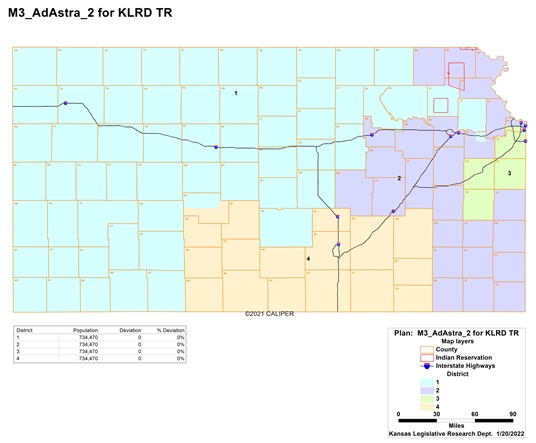The state is heading toward a landmark ruling, regardless of which side the courts take
by Dylan Lysen, KCUR and Kansas News Service
Lawrence, Kansas — This liberal college town is vote-rich territory for Kansas Democrats.
But a new map of congressional districts lumps it with deep-red western Kansas — all but nullifying the ballots of the blue voters here and proving once again the power of gerrymandering.
But a novel legal challenge hopes to upend the usual response of going to federal court to block the political cartographers — in this case, Kansas Republicans — from squeezing out the influence of the opposition party.
Instead, lawsuits rely on state courts and interpretations of the Kansas Constitution, rather than the U.S. Constitution, to stop political parties from putting their fingers on the scale.
In the meantime, the state’s lone Democratic congressional district hangs in the balance.
The ACLU of Kansas is suing to have the state’s recently drawn congressional redistricting map thrown out. The organization argues Republican lawmakers drew the new districts in an attempt to dilute the ballots cast by voters in the Democratic strongholds of Lawrence and Wyandotte County.
If the map holds up, Republicans would improve their chances to place conservative lawmakers in all four districts that represent the state in the U.S. House. Democratic U.S. Rep. Sharice Davids, who represents the Kansas City area, would be most at risk of losing her seat after seeing part of her base shifted from her district.
Sharon Brett, legal director for ACLU of Kansas, said that would be unfair to voters.
“This is an attempt by politicians to choose their voters,” she said, “rather than have voters choose their politicians.”
But Republican state lawmakers argue the newly drawn districts don’t hurt Davids or any Democratic candidates. They said the changes were needed to account for the growing population in the Kansas City suburbs.
How the courts rule on the case will determine the congressional districts for the next decade, and perhaps the rules for drawing them well beyond that.
Christopher Gunn, a Washburn University law professor who specializes in elections, said legal challenges to gerrymandering have never previously occurred in the state’s judicial system.
“They’ve never had an opportunity to say ‘Yes, the Kansas Constitution does protect individual Kansans from partisan gerrymandering,’” Gunn said. “So we’re going to find out, probably by the end of this year, whether or not that right does exist in Kansas.”
New legal strategy
Historically, legal challenges to redistricting maps occurred under federal law. But lawsuits lately instead make arguments under state constitutions and statutes.
Gunn said that shift in strategy emerged because recent federal court rulings found that political gerrymandering is not an issue they should be deciding. That led to voting rights groups searching elsewhere to make their cases.
The lawsuits in Kansas specifically cite the state constitution as the basis of their challenges. That’s a new legal argument in the state.
“This has never occurred in Kansas before,” Gunn said. “We don’t know what the (Kansas) Supreme Court is going to rule in terms of what the Kansas Constitution does protect in terms of the redistricting process.”
Gunn said the result of the case will be a landmark ruling either way the court decides. It could also set the foundation for prohibiting gerrymandering in Kansas in years to come.
But the case may not end there. If the Kansas courts strike down the maps, it could lead to an appeal in the U.S. Supreme Court.
Similar attempts have been tried in disputes in Pennsylvania and North Carolina. But the Supreme Court chose not to take those cases and their state court decisions stayed intact.
But Michael Li — senior counsel for the Brennan Center for Justice, a national nonprofit focused on election policy and voting rights — said some U.S. Supreme Court justices wanted to hear the Pennsylvania and North Carolina cases. He said Kansas could bring the issue to the nation’s highest court.
“A lot of people’s eyes are going to be on Kansas, both to see whether the state courts are willing to be the police force against gerrymandering but also how Kansas might play into this national argument,” Li said.
But how long the cases take to get through the courts may also play into the issue. Gunn said if the Kansas court system does not come to a final ruling on the issue before the candidate registration deadline in June, the map would likely stay in effect for the 2022 elections.
Shifting districts
Under the proposed map, Wyandotte County’s racially diverse voting population would be split into two separate districts — shifting part from the 3rd Congressional District represented by Davids to the 2nd Congressional District by Republican U.S. Rep. Jake LaTurner.
Meanwhile, Lawrence would shift from the 2nd District, which covers most of eastern Kansas, into the 1st District which primarily covers central and western Kansas. The new version of the 1st District stretches hundreds of miles from the northeast Kansas college town to the Colorado border nearly 400 miles west.
Brett said those changes are meant to negate Democratic strongholds. Some Lawrence residents see it that way, too.
“The move to gerrymander us into the 1st District was definitely an attempt to quiet the strong Democratic leanings of Lawrence,” Darby Harris said.
Lawrence resident Debbie Milks said the Republican majority of the Kansas Legislature created the map to try to get its party’s candidates elected.
“They, without any shame, just want to elect those of their own and not really care about representing the rest of us,” she said.
ACLU of Kansas and others filed lawsuits on behalf of residents in those districts. A trial for those cases began this week.
Republican push for the map
When the new districts were presented on the floor of the Kansas Senate, Republican leaders argued that the map was fair.
Sen. Rick Wilborn, who is the top Republican serving on the redistricting committee, said the committee needed to split Wyandotte County because of the growing population in Kansas City. He also said Davids would not be hurt by the new map.
“(Davids) would have won the new district just as much as she did before,” Wilborn said. “That’s true of all of the other congressional members. So there’s no attempt to eliminate a Democratic district.”
But Democratic lawmakers disagreed and tried repeatedly to offer a different version of the map that kept Wyandotte County mostly in one piece.
Sen. Dinah Sykes, the highest-ranking Democrat on the redistricting committee, said she knows shifting of the districts needed to occur around Wyandotte County. But she said the redistricting committee settled on a partisan plan intended to raise the clout of some voters and diminish the impact of others.
“Do we want a democracy,” Sykes said, “or do we want someone who has complete and ultimate control over everything in our government?”
Dylan Lysen reports on politics for the Kansas News Service. You can follow him on Twitter @DylanLysen or email him at dlysen (at) kcur (dot) org.
The Kansas News Service is a collaboration of KCUR, Kansas Public Radio, KMUW and High Plains Public Radio focused on health, the social determinants of health and their connection to public policy.
Kansas News Service stories and photos may be republished by news media at no cost with proper attribution and a link to ksnewsservice.org.
See more at https://www.kcur.org/news/2022-04-05/republicans-face-a-new-kind-of-legal-challenge-for-cutting-up-democratic-strongholds-in-kansas.


